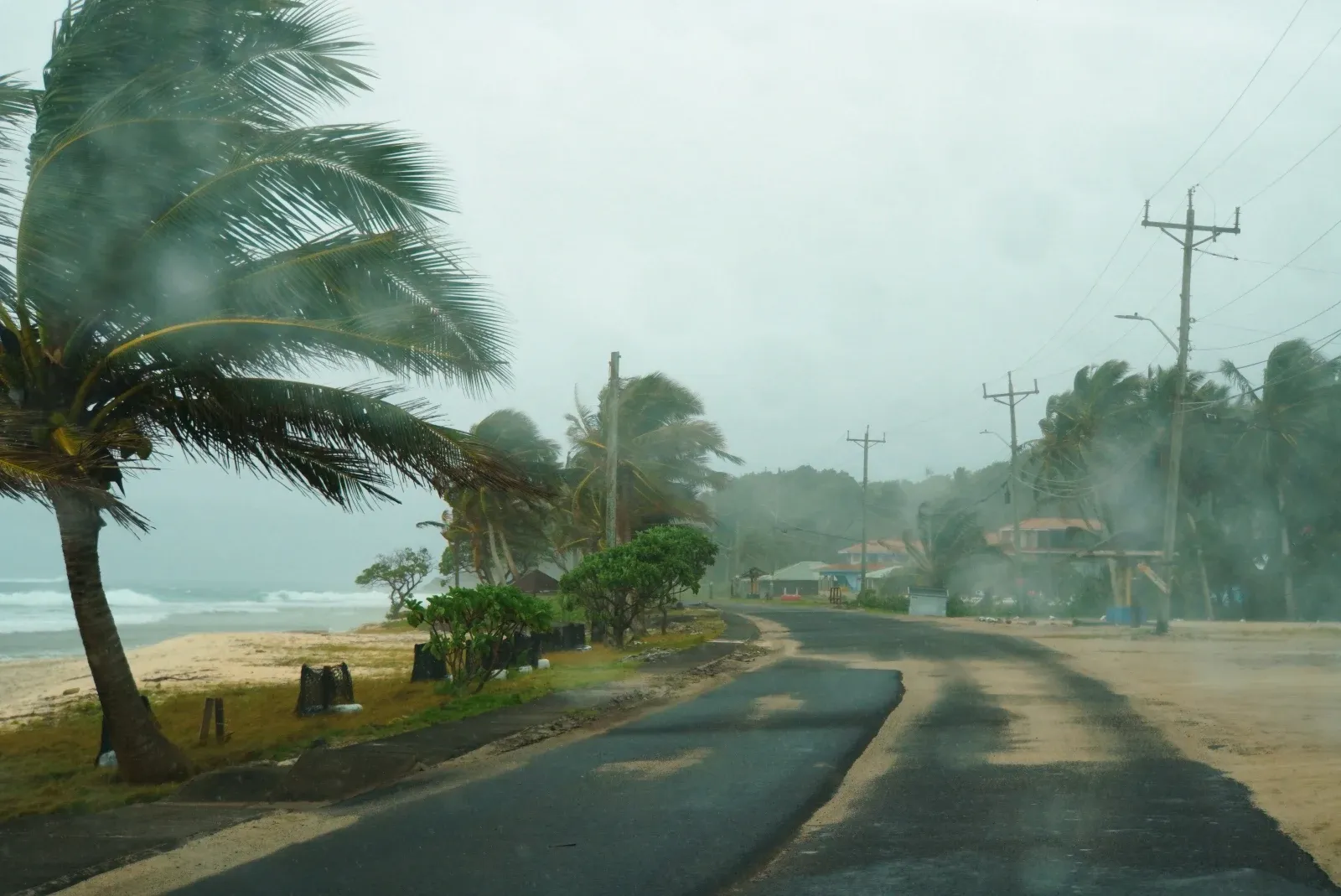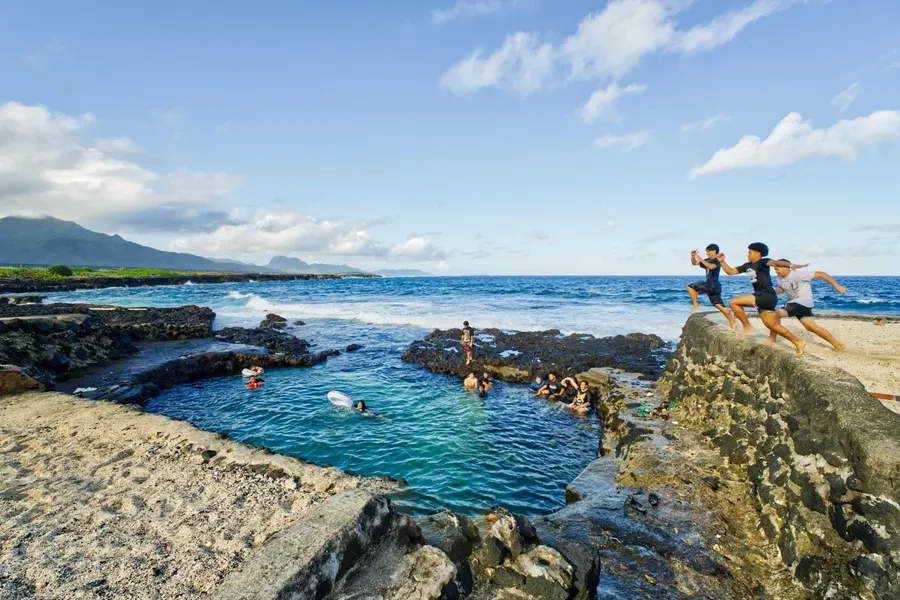What You Need to Know About Cyclones in American Samoa
Tropical hurricanes (known as cyclones in the South Pacific) can occasionally impact American Samoa. The cyclone season runs from November to April, and if you're visiting during this time, there is a risk of a tropical storm or cyclone passing through. Although these events are relatively rare, it's wise to prepare and know what to do should a cyclone warning be issued.
American Samoa has well-established emergency systems in place, including early warning alerts, storm shelters and evacuation routes, so residents and visitors alike are well protected during severe weather events.
Don't let the cyclone risk deter your trip; simply stay alert and follow safety guidelines if a warning is issued.
For more detailed seasonal insights, check out our American Samoa Weather, Seasons & Climate + Weather by Month guides.
Table of Contents
When is the Cyclone Season in American Samoa
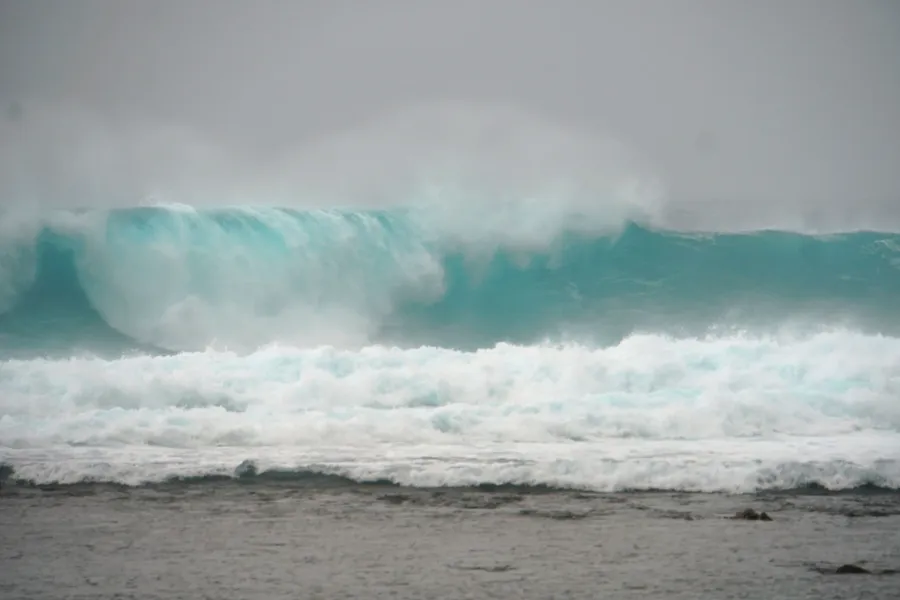
Cyclone Warnings in Samoa
American Samoa's tropical cyclone season runs from November to April, and a network of agencies closely monitors potential storms.
The Weather Service Office (WSO) Pago Pago works in coordination with the Central Pacific Hurricane Center and Joint Typhoon Warning Center in Honolulu, the Meteorological Service Offices in Apia, and the Regional Specialised Meteorological Centre (RSMC) in Nadi to issue cyclone watches and warnings.
Thanks to this system, developing storms are detected early, giving locals and travellers plenty of time to prepare.
How Cyclones Are Reported
Cyclones typically begin as tropical depressions. Once sustained winds reach 40–73 mph (65–120 kph), the system is classified as a tropical storm.
When wind speeds climb further, it is upgraded to a cyclone and given a name (e.g. Cyclone Ofa in the 1990s). These cyclones are categorised from Category 1 (55–78 mph / 88–125 kph) up to Category 5 (over 155 mph / 250 kph) based on severity.
Meteorologists track each storm's progress and issue a five-day forecast showing its projected path. Although the path can shift, early warnings are widely broadcast through radio, local alerts and emergency sirens to ensure communities and visitors have time to act.
%20CREDIT%20AmericanSamoaPocketGuide.com-900x600.webp?v=2025-12-19T06%3A36%3A28.673Z)
The Dangers of Cyclones
Why do you need to prepare for a cyclone? The severe gale force winds can cause significant damage to weaker structures in American Samoa, for instance, buildings in villages. There may also be damage to power lines causing blackouts, damage to crops and trees, and dangerous airborne debris.
Another danger can be contaminated tap water, although we recommend that you always filter (with a Lifestraw bottle, for instance) or boil tap water in American Samoa unless you know your accommodation is treating the water - see Is the Water Safe to Drink in American Samoa?
It’s important to note that cyclone damage is quite localised, significantly affecting the areas in its path rather than the entire country.
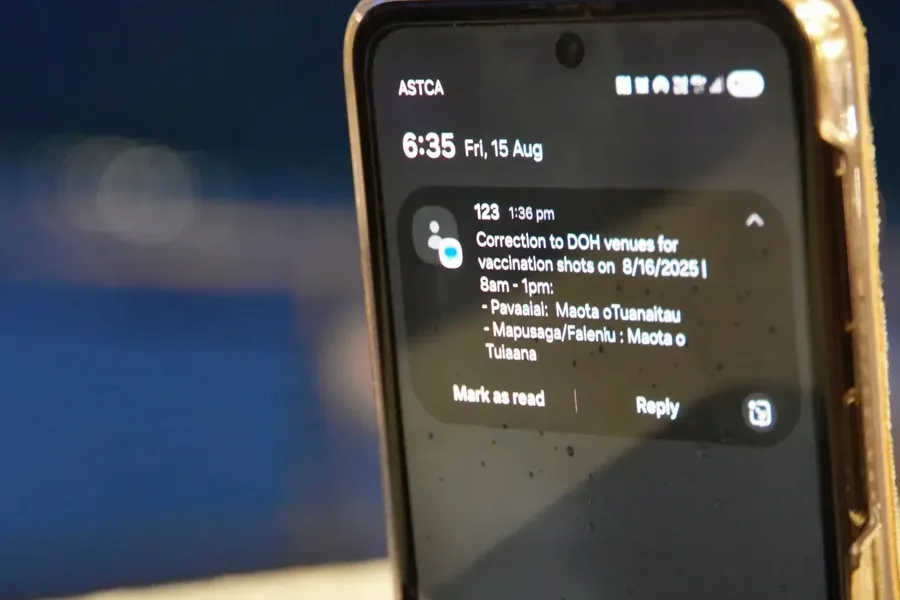
How to Prepare for a Cyclone
If you're visiting American Samoa during cyclone season (November to April), one of the best things you can do is stay on top of local weather alerts. The Weather Service Office (WSO) Pago Pago issues real-time cyclone watches and warnings in coordination with agencies like the Central Pacific Hurricane Center, the Joint Typhoon Warning Center in Honolulu and RSMC Nadi.
You can find updates on the US National Weather Service Pago Pago American Samoa Facebook page and weather.gov/ppg. The American Samoa Department of Homeland Security also issues warnings on its social media.
Given how unpredictable cyclones can be, it's always better to be overprepared than underprepared.
If you're staying in a hotel or guesthouse, ask the staff about their cyclone procedure. They'll be able to advise on the safest area of the building in case you need to shelter in place.
Prepare a basic emergency kit with food, water, clothing and medication for at least three days. It's also helpful to have a battery-powered radio or a fully charged power bank to get updates via your phone.
A flashlight and extra batteries are also essential. Emergency services in American Samoa can be reached by dialling 911.
Keep following the news and progress of the cyclone through radio, TV, text messages (you have to sign up for text alerts) and online news outlets. You’ll be informed if evacuation is necessary and where to go for evacuation.
Official advice will be given through local radio, TV and text messages. Learn more about getting an American Samoa phone number in The Best SIM Cards in American Samoa for Travellers.

A History of Cyclones in American Samoa
While cyclones form in the South Pacific at least once per year, only some have affected American Samoa since records began. Based on historical storm tracks and climate data from NIWA, American Samoa has experienced an average of 1.7 tropical cyclones per decade, equivalent to roughly a 17% chance of a cyclone passing nearby in any given 10-year period
Below is a record of cyclones that have affected American Samoa since 1848.
Cyclone Cilla
Cyclone Cilla impacted American Samoa, bringing moderate rainfall across the region, with a peak of 56 mm (2.21 in) recorded in Asasfou.
Cyclone Ofa
Cyclone Ofa passed about 160 km (100 mi) west of Pago Pago in February 1990, bringing wind gusts up to 160 kph (100 mph) that caused widespread damage across American Samoa, estimated at US$50 million. A state of emergency was declared, and U.S. President George H. W. Bush later designated the territory a federal disaster area, allowing residents to access federal aid for recovery.
Cyclone Olaf
Cyclone Olaf, a powerful Category 5 storm, struck American Samoa in 2005, bringing destructive winds up to 201 kph (125 mph) and causing widespread damage. Schools and businesses were closed, and the storm devastated parts of the Manua Islands, especially Ta'u, where up to 90% of infrastructure was destroyed. Thousands lost power, crops were ruined, and three people were rescued offshore after their boat sank near Pago Pago.
Cyclone Gita
Cyclone Gita hit American Samoa on 9 February 2018, bringing strong winds, heavy rain and widespread damage. Thousands of homes were affected, power and water were lost, and ports and airports were shut. Crop losses disrupted food supplies, and two vessels sank offshore. Damage was estimated at up to US$200 million, though no deaths or injuries were reported.
Cyclone Amos
Cyclone Amos was initially forecast to make a direct hit on American Samoa on 24 April, but a last-minute shift in its path spared Pago Pago, which received just over 76 mm (3 in) of rain. It became the strongest cyclone to impact the region since Cyclone Evan in 2012, with only three cyclones passing near American Samoa since 1959.
Cyclone Keli
A rainfall total of 160 mm (6.3 in) was reported at Afono in American Samoa.
Cyclone Val
Cyclone Val impacted American Samoa for five days in December 1991, bringing 240 kph (150 mph) winds and 15 m (50 ft) waves that caused widespread destruction. Initially issued a gale warning, the territory was later placed under a hurricane warning as the storm looped back toward the islands. Damages were estimated at around US$100 million, and one fatality was reported. The U.S. government declared American Samoa a major disaster area on 13 December.
Cyclone Waka
American Samoa was impacted by heavy rainfall totalling 56.9 mm (2.24 in) and wind gusts reaching 90 kph (56 mph), which caused minor crop damage and downed a few trees. The overall losses were estimated at US$120,000, while large swells affected the islands for about a week as the storm moved through the region.
Cyclone Wilma
Cyclone Wilma struck American Samoa on 23 January 2011, bringing winds over 95 kph (60 mph), heavy rainfall of 243 mm (9.56 in) and causing power outages, landslides and moderate structural damage. Three people died—two from flooding and one from high seas—while preparations included opening shelters and boarding up homes; despite the damage, power and water were restored within two days, and recovery efforts began promptly.
Cyclone Heta
Severe Tropical Cyclone Heta, a Category 5 storm with winds reaching 260 kph (160 mph), struck American Samoa in late December 2003, causing moderate damage and prompting a large-scale relief operation. One death was reported, 140 people were evacuated to shelters, and both a state of emergency and federal disaster declaration were issued, allowing for U.S. aid throughout 2004.
Cyclone Evan
The Pago Pago National Weather Service issued a gale watch for all of American Samoa ahead of the storm, later upgrading to hurricane warnings and flash flood watches as Evan intensified. Fortunately, no major damage or injuries were reported after the storm passed on 14 December.
Cyclone Meena
Cyclone Meena formed northwest of Pago Pago and passed within 160 km (100 mi) of American Samoa's Manu'a Islands, bringing wind gusts up to 90 kph (55 mph). In response, authorities closed schools, warned of heavy rain and flooding, and cancelled or delayed regional flights.
Cyclone Percy
Cyclone Percy struck Swains Island in American Samoa with strong winds that wiped out power and communications, leaving the island unreachable for a week. Despite the destruction of nine out of eleven buildings, all eight residents survived. Damage elsewhere in American Samoa was minimal.
Cyclone Tam
Cyclone Tam brought heavy rain and strong winds to American Samoa, triggering floods, mudslides and scattered power outages. The storm flooded buildings, tore roofs off some homes and destroyed around 70% of the island's crops, with total damage estimated at US$26,000.
Cyclone Tino
Cyclone Tino impacted American Samoa on 17 January, bringing peak winds of 74 kph (46 mph) and causing widespread disruptions. Trees and billboards were toppled, roads were blocked, and several communities experienced power outages due to the storm.
Cyclone Tusi
Cyclone Tusi struck American Samoa's Manu'a Islands at peak intensity, bringing hurricane-force winds of up to 177 kph (110 mph) and heavy rainfall. The storm caused extensive damage, particularly on Ofu-Olosega and Ta'ū, where 95% of homes were destroyed and around 2,000 people were left homeless. Crops, housing and infrastructure were severely affected, with damage estimated at over US$80 million.
Cyclone Ula
While Cyclone Tusi did not result in confirmed fatalities, one fisherman in Faleasao, American Samoa, was swept out to sea by large swells and went missing. Despite 72 hours of search efforts, he was never found.
Cyclones in American Samoa, Month-by-Month
- January: 1966, 1987 (Tusi), 2003 (Cilla), 2006 (Tam), 2011 (Wilma), 2016 (Ula), 2020 (Tino)
- February: 1903, 1915, 1990 (Ofa), 2005 (Meena), 2005 (Olaf), 2005 (Percy), 2018 (Gita)
- April: 1848, 1850, 1913, 2016 (Amos)
- June: 1997 (Keli)
- December: 1930, 1991 (Val), 2001 (Waka), 2003–2004 (Heta), 2012 (Evan)
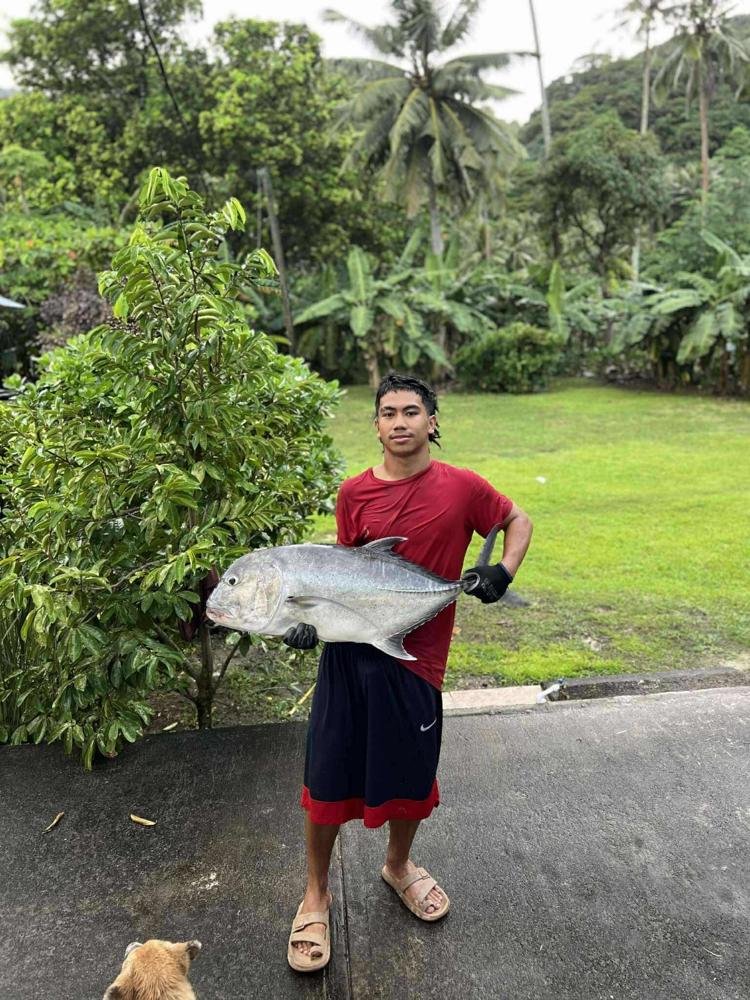
Editor's Choice
North Shore Tours
Discover the ancient art of traditional Samoan fishing on our authentic shoreline excursion. We'll teach you to master bamboo and fou tree pole fishing techniques whilst exploring pristine, remote...
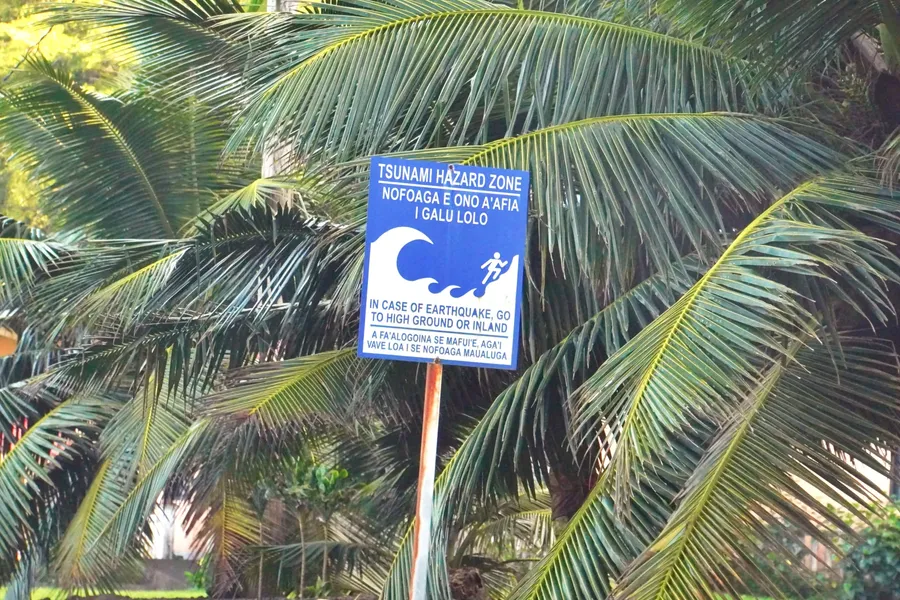
Frequently Asked Questions About Cyclones in American Samoa
Now that you know about cyclone preparedness in American Samoa, here are the answers to the internet's frequently asked questions about staying safe during cyclone season!
When is hurricane season in American Samoa?
The hurricane season in American Samoa typically runs from November through April. During this period, the island is most vulnerable to tropical cyclones and severe weather systems.
What should I include in my cyclone emergency kit?
Your cyclone emergency kit should include at least three days' worth of water (4 litres per person per day), non-perishable food, a battery-powered radio, torches, first aid supplies, medications, important documents in waterproof containers, cash and mobile phone chargers. Don't forget items for infants, elderly family members, and pets if applicable.
What are the cyclone warning categories in American Samoa?
American Samoa follows the National Weather Service cyclone warning system, which includes Tropical Cyclone Watch (issued 48 hours before expected impact), Tropical Cyclone Warning (issued 36 hours before expected impact), and various categories based on wind speed and potential damage. These warnings are broadcast on local radio stations and through emergency alert systems.
How do I stay informed during a cyclone in American Samoa?
Stay informed by monitoring local radio stations such as KVZK-AM and KSBS, following the American Samoa Emergency Management Agency on social media, and keeping a battery-powered or hand-crank radio for emergency broadcasts. Mobile phone networks may be disrupted, so having multiple communication methods is essential.
More About Cyclones in American Samoa
That's it for our complete guide to cyclones in American Samoa and how to prepare. For more about natural disasters and safety in American Samoa, take a look at the following guides:
- The Guide to Tsunamis & Earthquakes in American Samoa
- American Samoa Safety Tips: Is it Safe to Travel to American Samoa?
- American Samoa Weather, Seasons & Climate + American Samoa Weather by Month
Finally, get all of the tips required for a smooth getaway to the islands from our 30 Tips for Travelling in American Samoa.


